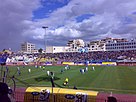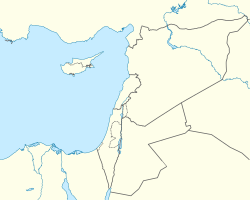
Back Homs Afrikaans حمص Arabic ܚܡܨ (ܡܕܝܢܬܐ) ARC حمص ARZ Homs AST ХӀумс AV Hüms Azerbaijani حمص AZB Хомс Byelorussian Хомс Bulgarian
Homs
حمص | |
|---|---|
City | |
Homs city landmarks Martyrs' Square with the Old Clock • Khalid ibn al-Walid Mosque • Al-Baath University • Khalid ibn al-Walid Stadium | |
| Nickname(s): Mother of the black stones (أم الحجار السود)[1] Al-'Adhiyyah ([الْعَذِيَّة] Error: {{Lang}}: invalid parameter: |3= (help))[a] The city of Ibn Al-Walid (مدينة ابن الوليد) The House of Peace (دار السلام)[citation needed] | |
| Coordinates: 34°43′51″N 36°42′34″E / 34.73083°N 36.70944°E | |
| Country | |
| Governorate | Homs Governorate |
| District | Homs District |
| Subdistrict | Homs Subdistrict |
| First settled | 2000 BC |
| Government | |
| • Governor | Namir Habib Makhlouf[4] |
| • Mayor | Abdullah Al-Bawab |
| Area | |
• City | 48 km2 (19 sq mi) |
| • Urban | 76 km2 (29 sq mi) |
| • Metro | 104 km2 (40 sq mi) |
| Elevation | 501 m (1,644 ft) |
| Population (2017, est.) | |
• City | 775,404[3] |
| Demonyms | English: Homsi Arabic: حمصي, romanized: Himsi |
| Time zone | UTC+2 (EET) |
| • Summer (DST) | UTC+3 (EEST) |
| Area code(s) | Country code: 963 City code: 31 |
| Geocode | C2528 |
| Climate | Csa |
Homs (UK: /hɒms/ HOMSS, US: /hɔːms, hɔːmz, hʊms/ HAWMSS, HAWMZ, HUUMSS;[5][6][7][8] Arabic: حِمْص / ALA-LC: Ḥimṣ [ħɪmsˤ]; Levantine Arabic: حُمْص / Ḥomṣ [ħɔmsˤ]), known in pre-Islamic Syria as Emesa (/ˈɛməsə/ EM-ə-sə;[8][9] Ancient Greek: Ἔμεσα, romanized: Émesa),[10] is a city in western Syria and the capital of the Homs Governorate. It is 501 metres (1,644 ft) above sea level and is located 162 kilometres (101 mi) north of Damascus.[11] Located on the Orontes River, Homs is also the central link between the interior cities and the Mediterranean coast.
Before the Syrian civil war, Homs was a major industrial centre, and with a population of at least 652,609 people in 2004,[12] it was the third-largest city in Syria after Aleppo to the north and the capital Damascus to the south. Its population reflected Syria's general religious diversity, composed of Sunni and Alawite Muslims, and Christians. There are a number of historic mosques and churches in the city, and it is close to the Krak des Chevaliers castle, a World Heritage Site.
Homs did not emerge into the historical record until the 1st century BC at the time of the Seleucids. It later became the capital of a kingdom ruled by the Emesene dynasty who gave the city its name. Originally a center of worship for the sun god El-Gabal, it later gained importance in Christianity under the Byzantines. Homs was conquered by the Muslims in the 7th century and made capital of a district that bore its current name. Throughout the Islamic era, Muslim dynasties contending for control of Syria sought after Homs due to the city's strategic position in the area. Homs began to decline under the Ottomans and only in the 19th century did the city regain its economic importance when its cotton industry boomed. During French Mandate rule, the city became a center of insurrection and, after independence in 1946, a center of Baathist resistance to the first Syrian governments. During the civil war, much of the city was devastated due to the Siege of Homs; reconstruction to affected parts of the city is underway with major reconstruction beginning in 2018.[13][14]
- ^ Al-Dbiyat 2013, p. 160
- ^ Almaany Team. "معنى كلمة عَذية في معجم المعاني الجامع والمعجم الوسيط – معجم عربي عربي – صفحة 1". almaany.com. Retrieved 24 October 2017.[dead link]
- ^ Cite error: The named reference
World Population Reviewwas invoked but never defined (see the help page). - ^ "President al-Assad issues decrees on appointing new governors for eight Syrian provinces". Syrian Arab News Agency. 20 July 2022. Archived from the original on 20 July 2022. Retrieved 15 August 2022.
- ^ "Homs". The American Heritage Dictionary of the English Language (5th ed.). HarperCollins. Retrieved 19 April 2019.
- ^ "Homs". Collins English Dictionary. HarperCollins. Archived from the original on 19 April 2019. Retrieved 19 April 2019.
- ^ "Homs" Archived 19 April 2019 at the Wayback Machine (US) and "Homs". Lexico UK English Dictionary. Oxford University Press. Archived from the original on 15 February 2020.
- ^ a b "Homs". Merriam-Webster.com Dictionary. Merriam-Webster. Retrieved 19 April 2019.
- ^ "Emesa". Lexico UK English Dictionary. Oxford University Press. Archived from the original on 29 January 2020.
- ^ Vailhé, Siméon (1909). "Emesa". Catholic Encyclopedia. Robert Appleton Company. Archived from the original on 10 March 2009. Retrieved 26 February 2009.
- ^ "Distance Between Main Syrian Cities". HomsOnline. 16 May 2008. Archived from the original on 8 March 2009. Retrieved 26 February 2009.
- ^ 2004 census.
- ^ "11 Million Dollars for Reconstruction in Homs. – Syria Scope". www.en.syria-scope.com. Archived from the original on 3 December 2017. Retrieved 3 December 2017.
- ^ "Life in the aftermath: A wounded Homs city struggles to reconcile its past". Syria Direct. Archived from the original on 9 November 2018. Retrieved 16 January 2019.
Cite error: There are <ref group=lower-alpha> tags or {{efn}} templates on this page, but the references will not show without a {{reflist|group=lower-alpha}} template or {{notelist}} template (see the help page).






